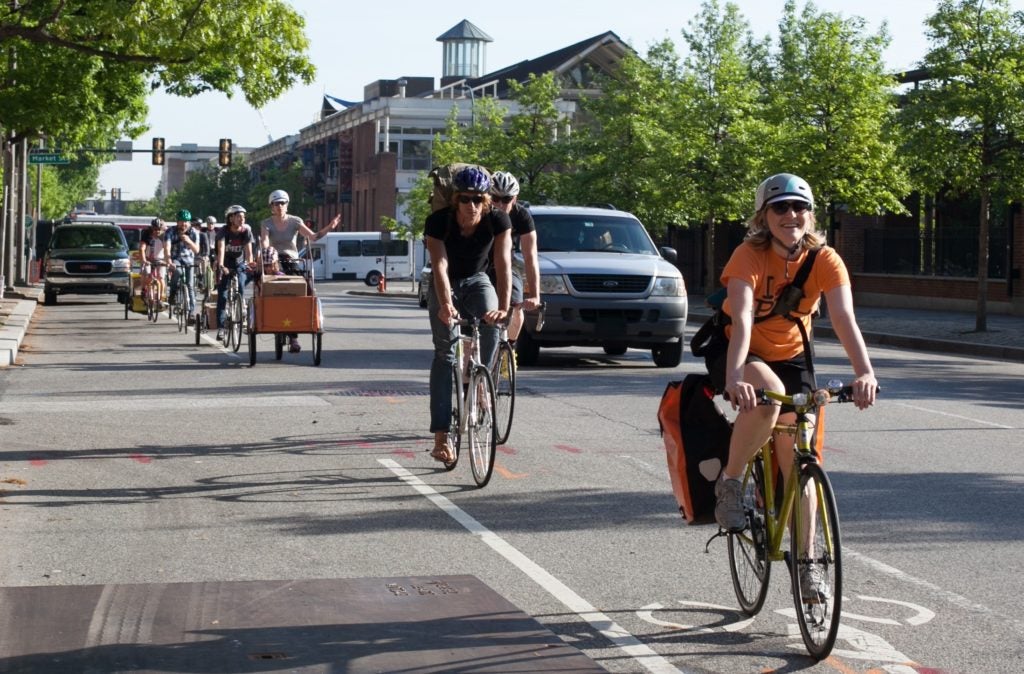She took on the role late in 2013, after having worked for Bicycle Coalition for more than three years as a Community Representative. Bicycle Coalition had just merged with another nonprofit, Cadence Youth Cycling, whose programs brought life and leadership skills to inner-city youth through sport racing. Megan would be tasked with running all of their programs in addition to her own workload.
“I really felt like I was managing chaos,” she says.
Fortunately, her supervisor told her that if at any time she felt she could use educational opportunities to support the job, she should just say so. Megan had always told herself that she would never go to grad school. But in the midst of these brand-new professional challenges, she decided it was time to ask for help.
When Megan went looking for opportunities to develop her skills in impact leadership, she knew what she wanted out of a program. It had to be flexible; she had to be able to continue on with her job; and it had to offer her practical skills, not just theoretical frameworks, to apply to her current work.
Megan looked at other leadership institutes, but when she discovered the Executive Education Program in Social Impact Strategy, something clicked. Instead of slogging through the application questions, she felt the answers flow out of her as easily as if she were being asked about herself by a new friend.
In her application essays, Megan was able to weave in all the most pertinent aspects of her personal and professional interests. She knew then that the Center for Social Impact Strategy doesn’t just look for what she calls “cookie-cutter people,” but rather “people at the verge of something.”
It was this holistic approach that drew her to the program, and brought her through it, secure in the knowledge that the teaching team would be able to meet her exactly where she was.
Megan recalls watching the lecture videos rapt, with pen in hand, pausing frequently to take notes on any insight she thought might inform her work at Bicycle Coalition.
Because what she was learning was so readily applicable to her day-to-day work, she even started viewing it as part of her professional routine. She was able to carve out part of her work week to review the course materials—which helped the ideas stay fresh in her mind as she put them into practice.
“The great thing about this program [is that] it gave me these really practical tools to work with,” Megan says; each week she was learning something new that had direct bearing on her work. She used her own programs as case studies to fill out logic models and her own Board experience to complete an analysis of their modes of governance. The assignments helped her to organize her thoughts around her existing work—and to identify gaps in her focus.
One assignment, in fact, got Megan to think about her Coalition work in a whole new way. When the Executive Program students were asked to complete a marketing matrix, Megan—who has no prior marketing background—realized just how useful a market segmentation approach like this could be for identifying and catering to stakeholders.
She was so excited about how the tool could be used to better promote and hone Bicycle Coalition’s programs that she asked her coworkers to help her think through how to develop such a matrix. She admits that because she pulled other people into the work, she submitted the assignment late—but that the impact on Bicycle Coalition made the delay worth it.
Among the most effective things Megan learned, she says, was how to lay out exactly what your goals are for a program—and how to build your roadmap backwards from that point.
In reviewing the materials she inherited from Cadence Youth Cycling, Megan noticed something strange. Prior grant applications had suggested that their programs would result in increased academic performance for the student participants. But knowing what Megan now knew about outcomes, impact, and performance metrics, she started to realize that these old applications had been making promises on which they couldn’t deliver.
“What I can promise is that [participants] are going to have improved fitness, they’re going to have increased perseverance. That their view of the world is going to expand. That they’re going to learn about teamwork—all these things that cycling does and that are within our locus of control,” Megan explains.
Megan and her team scrapped the prior grant text and came up with brand new strategies to pitch to funders. In one instance, she was able to sit down with one of the foundations considering support of Bicycle Coalition. Megan explained in detail Bicycle Coalition’s new plan for enacting and assessing impact on their students—and her thorough, reasoned pitch resulted in a $5,000 grant for Bicycle Coalition.
Megan can’t say enough good things about what having internal documents like the logic model she created has done for Bicycle Coalition’s ability to secure funding, but she says it does more than that for her workplace—it bolsters her colleagues’ ability to do their jobs with clarity and focus. “If we’re asked to do things by our constituents, we’re able to go back and say, ‘That sounds nice, but this is actually what we’re trying to accomplish,’” she explains. “We need to first see if it fits back into what our vision was, or if our vision needs to be altered.”
She likens these internal documents to roadmaps, and she says they help her feel more secure in offering direction to her workers.
“I think that empowers the people that I’m managing when they know where they’re headed,” she says. “It feels so good to have a plan, and to have answers to questions.”
The Executive Program came at an auspicious time in Megan’s life and in the Bicycle Coalition’s history. 2016 will be the last year of Bicycle Coalition’s current strategic plan, so the next cycle of strategic planning is underway—and Megan is excited to stick around to help with the process.
“I’m sure that I will be more valuable now to that process than I was a year ago,” she asserts.
Megan Rosenbach continues to be full of ideas and heart—but she now has a slate of tools to focus her energies in productive new ways. She’s excited to get back to Bicycle Coalition and to pull together all departments—education, development, communications—in ways that are both efficient and generative.
“Bicycle Coalition is really well-regarded and really not well-known for the velocity of work that we’re doing. I want to change that,” she says. “I want to make sure that as we grow internally, our external presence is growing too. I think one of the ways to do that is being really well-organized internally about our vision and about what our programs are accomplishing.”
It’s easy, she says, to get excited about what she’s doing at Bicycle Coalition. “There is just so much joy in it. We are advocating for something that brings joy to people’s lives.”
But now, she feels, she can get excited about how she gets it done. “I’m not just managing chaos. I’m strategic about what I’m doing,” she says.



